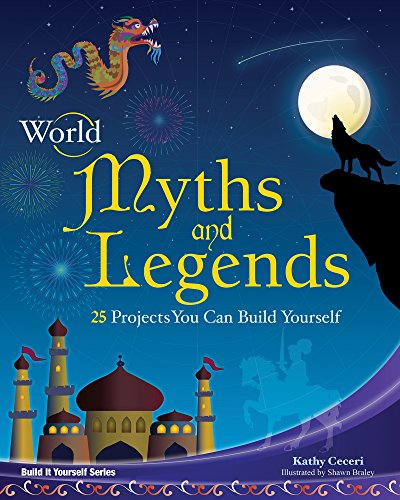Title of the work
Country of the First Edition
Country/countries of popularity
Original Language
First Edition Date
First Edition Details
Kathy Ceceri, World Myths and Legends: 25 Projects You Can Build Yourself. Nomad Press, White River Junction VT, 2010, 128 pp.
ISBN
Genre
Activity book*
Myths
Target Audience
Children (9–12 years)
Cover
 Courtesy of the publisher.
Courtesy of the publisher.
Author of the Entry:
Ayelet Peer, Bar-Ilan University, ayelet.peer@gmail.com
Peer-reviewer of the Entry:
Lisa Maurice, Bar-Ilan University, lisa.maurice@biu.ac.il
Susan Deacy, University of Roehampton, s.deacy@roehampton.ac.uk

Shawn Braley (Illustrator)
Shawn Braley is an American illustrator. The biggest influence on his work is nature and animals. His work gained recognition and appeared in books, newspapers, magazines and commercial projects.
Source:
Author's website (accessed: June 24, 2021).
Bio prepared by Ayelet Peer, Bar-Ilan University, ayelet.peer@gmail.com

Portrait of Kathy Ceceri, courtesy of the author.
Kathy Ceceri (Author)
Kathy Ceceri is an American award-wining writer for children, as well as an instructional designer and maker. She is the co-founder of GeekMom website. The author also taught STEM enrichment classes in various places for 15 years and she develops entry-level technology projects for companies. Among her books are Making Simple Robots, Musical Inventions, Video Games: Design and Code Your Own Adventure.
Source:
Author's website (accessed: June 24, 2021).
Bio prepared by Ayelet Peer, Bar-Ilan University, ayelet.peer@gmail.com
Summary
This book includes information about myths from all over the world as well as handy craft activities for children. The book is divided into nine chapters, with each chapter displaying various myths from different cultures as well as a related activity.
The chapters are: What are myths and legends; The Middle East; Greece and Rome; Northern Europe; Sub-Saharan Africa; India and China; Japan and Australia; Central and South America; North America. The book also includes a glossary, a brief glossary of important names, templates, resources including books on mythology and relevant websites and an index.
The myths are accompanied by black and white illustrations.
The first chapter offers an overall explanation on the nature of myths and legends and the difference between the two. The remaining chapters focus on specific cultures. Each chapter includes "did you know" sections which provide further anecdotes; words to know sections; brief retelling of myths; and a building activity.
The Greek and Roman myths chapter covers:
- a table of Greek and Roman gods and goddesses, including not only the Olympians, but also Cronus, Nike, Eros and Pan,
- a brief narration of Pandora's myth,
- the creation of the world and the Titanomachy,
- Athena’s origin and Arachne,
- Greek inventions and a story about Daedalus,
- a description of Asclepius, Hippocrates and Delphi,
- the Trojan War and the Odyssey,
- Aeneas and the founding of Rome,
- a description of Cybele.
The activities included in this chapter are a mythic allusions collage, making a triangle with a compass and ruler and an Odyssey whirlpool.
Analysis
This book aims to unravel the rich world of myths from around the world to juvenile readers, and the building projects are intended to be fun activities in addition to reading, hence the two objectives complement each other.
The author tries to connect the ancient past with modern traditions and show the relevance of myths to our modern world. For example, in the description of the goddess Cybele, it is noted that April's Fool's Day may have originated from the Hilaria celebrations in Rome.
In the first chapter, the author offers an explanation of the difference between myths and legends. She explains that "A myth is a story about gods or magical creatures that people once believed was true. It is part of a mythology, a collection of related myths from one culture." [location 138]. While "legend tells the adventures of a hero who sets out to do something impossible." The author explains that myths and legends help to create group identity and provide explanations for natural events. She further notes the importance of myth in building national identity, that "mythologies could also help keep certain people in power. They did this by making a connection between a society’s rulers and its gods." [location 178] with a reference to the Japanese culture.
The author conveys many important facts about the various cultures, hence the book focuses more on providing information than on the actual retelling of the myths. The actual myths are briefly narrated. For example, the myth of Pandora (which is narrated under the "did you know" section) is quite succinct and was perhaps meant to explain the meaning of the phrase "Pandora's Box." I cite here the entire story as an example:
"Prometheus, whose name means "forethought," had a brother named Epimetheus, or "afterthought." Epimetheus' wife was the famous Pandora, or "all gifts." She was the first woman, a present from the gods to mankind. Pandora came equipped with a jar that she was not supposed to open. But she was curious, so she opened it anyway. Out popped all the evils of the world – Sickness, Despair, and War. Quickly she closed the lid, catching Hope inside before it could leave. Today a "Pandora's Box" is a bunch of trouble that’s better kept under wraps." [locations 571–572].
Since the book aims to bring the readers a brief survey of various world cultures and a taste of universal myths, the author cannot engage too deeply with each story and provides the outlines of several myths.
The author further includes information on the main ancient poets, such as Hesiod, Homer and Virgil. She mentions that Alexander the Great helped spread the Greek stories to the boundaries of India and that later the Roman empire would do the same. Therefore the readers can understand some of the myths that spread from ancient times until modern day.
The author celebrates the Greek myths and culture (she even attributes mosaics to the Greek) and in comparison, she explains that "The Romans preserved, copied, and adapted these works, as well as the stories themselves, making them even more famous." [locations 537-538]. Later she adds "after defeating Greece, the Romans combined the Greek myths with their own sacred traditions. Why? Because the Greek myths were much more lively and entertaining." [location 837]. She explains that the Romans viewed the gods only as spirits and protectors and not as having intricate social lives. While this may appear as if the Romans were mere copycats of the Greek pantheon and culture, it is important to indicate, as the author states, that it is mainly due to the Romans' endeavours that many of the Greek myths survived.
There are several inaccuracies throughout the text; for example, the author mentions that "When Aeneas leaves Dido to continue his journey to Italy, she curses him and promises eternal hatred between her city and his. In 218 BCE, Rome used this curse as a reason to attack Carthage and its ruler Hannibal." [location 840]. The Romans did not use the curse to attack Carthage but they did mention it later in Virgil's Aeneid, as the origin of the tension between the nations. However, this reference does illustrate the connection between the myth and the socio-political situation in Rome during the Punic Wars.
To conclude, the book aims to offer the readers a broader view of myths and legends and their importance to human societies and the development of various cultures all over the world.
Addenda
The review refers to the Kindle edition ASIN: B006PPJLK4.


